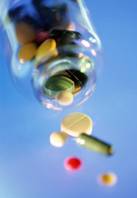Bipolar disorder facts revealed!
99 vital pieces of information on bipolar disorder:
Are you bipolar? Discover genuine bipolar test criteria.
1
Keep reading the important information on bipolar disorder below for:
- The REAL symptoms of bipolar disorder.
- Best free QUALITY bipolar resources.
- The truth about bipolar medications (hint = mood stabilizers).
- The latest and most effective treatments for bipolar, including natural treatments and bipolar diet and lifestyle MUST DOs.
Bipolar basics
1. Bipolar disorder used to be known as manic depressive illness.
2. It is a MOOD DISORDER characterized by MOOD SWINGS between the “highs” of bipolar mania and the “lows” of depression.
3. It is an episodic illness. In between episodes of bipolar mania and/or depression, there will usually be periods of stable or “normal” moods and wellness.
4. The usual age of onset is late teens to early twenties.
5. Bipolar disorder is NOT CURABLE and must be controlled by mood stabilizing medication. This is one of the most unpalatable but important bipolar disorder facts.
6. Despite being a life-long illness, bipolar disorder is very manageable. In fact, it is one of the “best” mental illnesses to have in that there are many effective bipolar treatments available.
7. Bipolar disorder is often misdiagnosed as depression in women or schizophrenia in men.
Reminder
Bipolar is frequently misdiagnosed so make sure you see an experienced psychiatrist.
8. Another common misdiagnosis is to pronounce someone bipolar when they really have borderline personality disorder.
9. Untreated bipolar disorder is dangerous and may lead to suicide during depression, or self destructive activities during bipolar mania such as wild spending, crazy business ventures, sexual promiscuity or infidelity, and other high risk behavior.
3 (10-15% of bipolar patients die by suicide)
10. Bipolar disorder must be diagnosed and treated by an experienced psychiatrist who specializes in mood disorders.
Bipolar resources you can trust
Bipolar disorder facts need to be distinguished from bipolar fictions.

Use these reputable and independent sources for accurate information about bipolar disorder:
11. Facts on Bipolar Disorder from National Institute of Mental Health (NIMH)
13. Bipolar Disorder from the Mayo Clinic

14. International Bipolar Foundation
15. Depression and Bipolar Support Alliance (DBSA)
Are you bipolar?

You may have bipolar order if you answer “YES” to ALL of the following questions.
If the following self-screen for bipolar is positive, you should see a psychiatrist who specializes in mood disorders to confirm and discuss any possible diagnosis of bipolar disorder. One of the frustrating bipolar disorder facts is that it requires highly skilled diagnosis.
16. Have you experienced depression for an extended period (at least 2 weeks)?
17. Was this depression so serious that it made your usual activities such as work or study impossible, or only barely possible through great personal effort?
18. As well as the serious lows of depression, have you also experienced periods of “highs” – of being so “up” that it felt like more than normal happiness? Perhaps to the point of interfering with your daily functioning?
19. Have you experienced periods of needing only small amounts (3-5 hours at most) of sleep?
20. Have you experienced racing thoughts or rapid, pressured speech?
21. Have you ever engaged in reckless behavior such as shopping sprees, credit card binges, or out of character promiscuous sex?
22. Have you ever had so much extra energy that you took on lots of extra projects, or needed lots of extra activity and stimulation or social contact?
23. Have these “ups” ever led to serious problems such as conflict at work or in your marriage or legal problems?
24. Do you have a close relative such as a parent, grandparent, brother, sister, uncle, or aunt who has bipolar disorder?
25. Has a psychiatrist or other mental health professional ever suggested to you that may have bipolar disorder?
THERE IS NO BLOOD TEST, X-RAY, BRAIN SCAN, MRI, GENETIC TEST, OR OTHER “MEDICAL” TEST THAT CAN IDENTIFY BIPOLAR DISORDER.
2
Bipolar symptoms
Symptoms of bipolar depression include:
26. Persistent empty or “blue” feeling.
27. Lack of interest or pleasure in usual activities.
28. Sleep changes – either insomnia or excessive sleep.
29. Lack of motivation and neglect of routine tasks such as personal grooming.
30. Indecision.
Symptoms of bipolar mania include:
31. Reduced need for sleep.
32. Grandiose plans and beliefs that are not realistic.
33. Racing thoughts.
34. Taking on multiple projects and marked increase in goal directed behavior.
35. Risk taking behavior and distorted judgment, for example crazy business schemes, reckless investments, sexual indiscretions, shopping sprees, gambling binges.
Causes of bipolar
36. Genetics. Bipolar disorder is NOT ALWAYS inherited and in even in identical twins, both do not always develop the disorder. Thus, although hereditary factors are a major risk factor in developing bipolar disorder, it is not a purely genetic illness.
37. Neurotransmitter imbalances and other brain chemistry disturbances.
38. Stress. Someone with a predisposition to bipolar may go on to develop the illness if triggered by stress.
39. Environmental factors such as seasonal changes or sleep deprivation sometimes precipitate the onset of bipolar episodes.
40. Pregnancy. Obviously pregnancy in and of itself does not cause bipolar disorder. However, like stress, giving birth can trigger the initial episode in a woman with a predisposition to the illness.
Types of bipolar disorder
41. Bipolar Type 1 is characterized by at least one manic or mixed episode. They nearly always experience major depressive or hypomanic episodes. The mania in Bipolar 1 is serious and can even involve bipolar psychosis.

42. Bipolar Type 2 is characterized by at least one hypomanic episode, (hypomania meaning literally ‘below mania’), and one major depressive episode.
43. The third bipolar type is called cyclothymia. This occurs when patients experience numerous episodes of hypomanic or depressive SYMPTOMS, but never meet the full threshold of being diagnosed as true hypomania or major depressive episodes.
4
44. If you do not fit into any one of these categories, you may be diagnosed as bipolar disorder NOS, not otherwise specified.
45. Some experts such as Dr Jim Phelps also consider the types of bipolar disorder to include Bipolar Type 3 – when an antidepressant causes the patient to switch into mania or hypomania. This is also called substance/medication induced bipolar.
Bipolar medications
46. Bipolar medications may be altered depending on the phase of the illness or the patient’s response to a drug. A different combination of meds may be required for maintenance, as opposed to managing an episode of acute bipolar mania or acute depression.

47. Lithium is the best known med for treating bipolar because it is a MOOD STABILIZER and is effective in treating both mania and depression, as well as maintenance therapy for preventing relapse.
5 (lithium use in bipolar)
48. Sometimes antidepressants are used to treat bipolar depression but this can be controversial because of the possibility of an antidepressant causing a switch into mania. This is one of the most misunderstood and under-appreciated bipolar disorder facts.
6 (risk of switch into mania with antidepressant)
49. Some atypical (latest generation) anti-psychotics have been approved for treating bipolar disorder as research has shown them to have mood stabilizing properties on top of their utility for bipolar mania.
50. Another of the misunderstood bipolar disorder facts is that most people spend MUCH MORE time experiencing depression as opposed to mania, and one of the most successful treatments for bipolar depression seems to be a combination of Lithium and Lamotrigine (Lamictal).
Bipolar treatments
51. All of these bipolar disorder facts are important. BUT some bipolar disorder facts are more important than others. In terms of getting well and staying well, it is critical to understand that the most proven approach is to COMBINE MEDICATION AND TALK THERAPY.
Not everyone wants to be psychoanalyzed, but there are other forms of talk therapy that are effective bipolar treatments.
52. Cognitive behavioral therapy (CBT) has a good track record as a bipolar disorder treatment. CBT helps us identify our self-defeating, unhealthy, negative beliefs and behaviors and teaches how to replace these with more constructive, realistic and helpful beliefs and actions.
This can be very useful in recognizing the stressors that trigger our bipolar episodes and learning to control them.
7 (CBT in preventing recurrence of bipolar episodes)
53. Psycho-education is all about learning as much as possible about bipolar disorder. Understanding your illness promotes treatment compliance (such as taking bipolar medications) and helps in determining the best treatments for you as an individual and also in recognizing warning signs of mania and depression so that bipolar episodes can be minimized and controlled.
8 (illness awareness in bipolar treatment)
54. Narrative therapy which helps someone with bipolar disorder understand the stories they tell themselves and to externalize their bipolar disorder in order to better solve associated problems.
55. Solution Focused Therapy, which differs from some talk therapy in that it is oriented towards the present and future and to practical solutions, rather than exploring the past or dwelling on problems.
56. Interpersonal and social rhythm therapy (IPSRT) is a treatment program that stresses maintaining a regular schedule of daily activities and stability in personal relationships. It is PROVEN to be very effective for people with bipolar disorder and is one of my own preferred approaches.
I would call it one of the best kept bipolar disorder facts secrets!
57. Electroconvulsive therapy (ECT) used to be one of the ugly bipolar disorder facts that nobody liked to talk about. Although still something of a bipolar treatment of last resort, ECT is now administered in much reduced strengths and so has far fewer side effects.
It is worth considering when bipolar medications are ineffective or during pregnancy when medications may put an unborn baby at risk.
58. Natural Treatments for Bipolar Disorder
Caring for a loved one with bipolar disorder
60. Take stock of your own mood patterns. One of the stranger bipolar disorder facts is the phenomenon known as assortative mating where studies have shown that people with bipolar disorder are more likely to couple with individuals who also have a mood disorder.
61. Caretakers need to be very well informed about all bipolar disorder facts. BOTH of you should work hard to learn as much as possible.
62. Put a “Wellness Plan” and “Treatment Contract” in place in case of emergencies.
63. Compliance is key. A relationship with someone who has bipolar disorder is much more “do-able” if they are taking their meds and participating in therapy.
64. Who cares for the caretaker? Make sure there is support for the caretaker as well as the patient in case of a relapse into mania or depression.
65. Life and love with someone who has bipolar disorder is like any relationship, including challenges and rewards. Remember that this is a manageable illness.
If treatment is followed then there will be positives such as a companion who is creative and captivating.
More bipolar disorder facts from Bipolar-Lives.com
66. Bipolar Disorder Statistics
67. Discovery of Bipolar Disorder
68. History of Bipolar Disorder
69. Bipolar Disorder and Creativity
Myths about bipolar disorder
70. A common myth is that bipolar disorder, once correctly diagnosed, is a distinct, precise illness. In fact, there are several types of bipolar disorder. In particular, Bipolar Type 1 as opposed to Bipolar Type 2. Bipolar disorder facts increasingly also require an understanding of soft bipolar and the bipolar spectrum.
71. Another myth is that mania is a fun high that is like an exaggerated form of being “the life and soul of the party”. Mania takes many different forms and can manifest as extreme irritability or even psychosis.

72. It is also a myth that bipolar people are crazy. They have a mood disorder and in between the highs of mania and lows of depression may have long and/or frequent periods of stable moods where they function well.
The true bipolar disorder facts are that many people go months or even years without an episode.
73. Another common misunderstanding relates to workplace functioning. Although some people are disabled by their bipolar disorder, more than 75% are successful at work.
74. Medication myths go both ways. Some folks mistakenly believe that bipolar is untreatable, while others believe that bipolar medications are a “cure.” On the positive side, there are a variety of bipolar medications available and finding effective treatment just may take some people a little longer.
A less palatable of bipolar disorder facts is bipolar medications control but do not cure the illness. It is necessary to always take meds, even when stable and everything is going well.
75. The myth that bothers me most is that bipolar disorder is not a real illness. Although bipolar disorder is episodic and very treatable, it is a serious illness and if untreated can lead to suicide and other terrible consequences.
76. Related to the myth above is the notion that bipolar is just a fashionable excuse for bad behavior and means whatever the “sufferer” wants it to mean. Bipolar disorder has a clear clinical definition and has been a documented chronic illness for over 2,000 years.
77. A myth I was WISH was true is that people with bipolar disorder are all creative geniuses. Although there is a VERY STRONG link between bipolar disorder and creativity (especially in unaffected relatives of bipolar individuals), it is possible to have bipolar disorder and not be especially creative or extra intelligent.
9 (genetic analysis of link between bipolar and creativity)
78. This one is not exactly a myth. It is more like one of the most surprising bipolar disorder facts – having bipolar disorder is not all-consuming. Sometimes I snap at my stepson because I am just another mom having a bad day. It does not mean I am manic.
Sometimes I cry during a movie. This does not mean I am depressed. If I drive a little recklessly sometimes, it may be I am simply running late. If I ace a job interview, it may be because I was well prepared, not because of my “hypomanic edge”.
79. One of the most misunderstood bipolar disorder facts is that bipolar disorder is not linked to criminal or violent behavior. The truth is that someone with bipolar disorder is more likely to be both a victim of violence and a perpetrator of violence.
10 (bipolar patients are more likely to be victim and perp of violence in Sweden)
Bipolar disorder and physical health
Some of the most important, least understood bipolar disorder facts relate to physical health:
80. People with bipolar disorder are twice as likely to die early from a medical illness.
11 (increased all-cause mortality in bipolar patients)
81. The main cause of premature death for people who have bipolar disorder are “lifestyle” or preventable/controllable factors such as heart disease, stroke, and diabetes.

82. This increased risk of early death applies equally to both men and women with bipolar disorder.
83. People with bipolar disorder are over twice as likely to smoke (51% versus 23%).
84. Bipolar disorder is also strongly correlated with overweight and obesity. One study showed bipolar disorder to be the mental health problem most strongly linked to weight gain.
Some research has indicated rates as high as 68% of overweight and obesity in bipolar populations.
85. These weight problems are also correlated with poorer overall mental health outcomes. For example, obese people with bipolar disorder have more episodes of both mania and depression, more serious episodes and more frequent episodes.
86. Bipolar frequently co-occurs with substance abuse.
12 (substance abuse in bipolar)
87. Bipolar frequently co-occurs with alcoholism.
88. The new atypical anti-psychotics that have become popular bipolar medications have serious side impacts that impact physical health and are especially tied to weight gain and diabetes.
89. On March 12, 2002, U.S. District Judge Henry H. Kennedy Jr. ruled that bipolar disorder is actually a physical illness because it can be inherited, can sometimes be identified by brain scans, and is a neuro-biological disorder characterized by chemical imbalances in the brain.
Living with bipolar – top 10 tips
90. Stay on your bipolar medications and do not make any changes without discussing your meds with your psychiatrist.
91. Do not use recreational or street drugs.
92. Minimize alcohol or abstain completely.
93. Maintain a regular sleep schedule.
94. Maintain a regular exercise schedule.
95. Control weight and mood swings by eating plenty of lean protein and vegetables, taking folic acid and fish oil, and avoiding sugar, “bad” fats, and simple carbs.
96. Join a bipolar disorder support group, for example through your local DBSA.
97. Make charting your moods on a Bipolar Mood Chart a daily practice.
98. Create a Wellness Plan and a Treatment Contract.
99. Read and learn everything you can about bipolar disorder!
 Medically reviewed by
Medically reviewed by